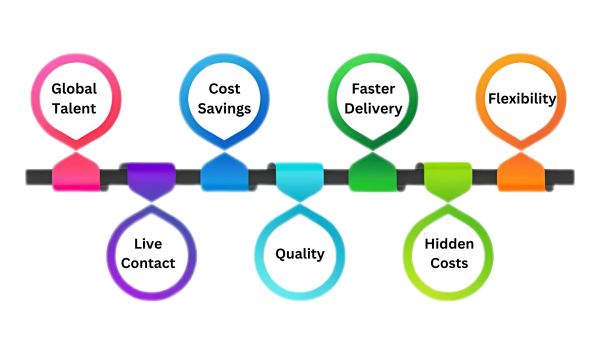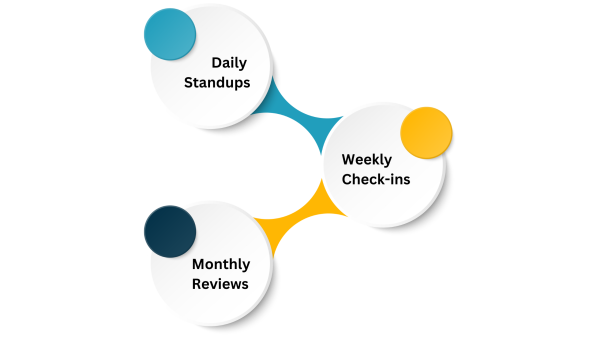Outsourcing software development is a huge advantage for businesses of all sizes. Imagine being able to access the world’s top tech talent without the hefty price tag of building an in-house team. This isn’t just a cost-cutting measure—though saving money is a significant perk—but it’s also about tapping into exclusive talent pools.
Remember when Skype outsourced its development to a team in Estonia and went on to revolutionize global communication? Or Google, which outsources many of its projects daily to manage its vast workload. These examples show how outsourcing can lead to groundbreaking products and services and that if you’re not outsourcing already, you’re missing a lot.
Still, one of the sweetest advantages of outsourcing is the ability to focus on what you do best. Let’s say you run a startup with a brilliant business idea but lack the technical skills to bring it to life. By outsourcing your software development, you can concentrate on refining your product, building customer relationships, and expanding your market. Meanwhile, a dedicated team of experts handles the nitty-gritty of coding and testing. This collaboration not only speeds up your time-to-market but also ensures that your software is built using the latest technologies and best practices.
Moreover, outsourcing offers incredible flexibility and scalability. Picture this: you’ve landed a massive project that requires more developers than you currently have. Instead of scrambling to hire and train new employees—which can be time-consuming and costly—you can quickly scale your development team by outsourcing. This approach allows you to meet project demands and adjust resources as needed.
In this blog, you’ll discover everything you need to know about software development outsourcing in 2024. We’ll dive into the latest trends, explore the benefits, and provide practical tips on overcoming common challenges. Whether you’re looking to save costs, access global talent, or speed up your projects, this guide will equip you with the knowledge to make informed decisions. Keep reading!
What is Software Development Outsourcing?
Think of software development outsourcing as hiring a super team to handle your tech projects. Instead of building your own team from scratch, you bring in experts from around the world to help you create, test, and maintain your software. This means you get access to a global talent pool without the hassle of full-time hiring.
Why Outsource Software Development?
Software development outsourcing has become a popular strategy for many businesses looking to stay competitive. With the help of external expertise, companies gain several advantages that help them achieve their goals.
- Tap into global talent
- Save money
- Speed up your projects
- Focus on what you do best
- Stay flexible
When you outsource, you tap into a global talent pool, accessing top-notch developers and specialists who might be hard to find locally. This broadens your options and ensures you get the best people working on your project. Additionally, outsourcing is more cost effective than hiring in-house staff. You save money on salaries, benefits, and overhead costs associated with maintaining a full-time team.
Software development outsourcing also significantly speeds up your projects. External teams can usually start immediately and work around the clock, reducing the time it takes to bring your product to market. This allows your in-house team to focus on what they do best, like strategy, marketing, or customer service. Moreover, outsourcing offers great flexibility. You can scale your team up or down based on your current project needs, avoiding the long-term commitment of hiring permanent employees.
Some additional perks of software development outsourcing are lower risks, better security, access to specialized skills, and high-quality products. But what exactly does this mean?
Well, lower risks are tied to in-house costs and delays due to overload, but when you outsource, your contract protects you from these issues. It’s similar with security; outsourcing firms prioritize data protection with encryption and regular audits. You also get access to specialized skills like AI and blockchain that might be hard to find locally. Plus, outsourcing companies follow strict development and testing processes, ensuring your software meets high standards.
But it’s not all sunshine and flowers. There are some things that require more of your attention. But don’t worry, we’re just about to get there. You just make sure to study and deploy them next time when outsourcing software development.

3 Common Challenges with Software Development Outsourcing
As we already said, outsourcing software development can bring many benefits, but it’s not without its challenges. Knowing these hurdles in advance will help you prevent them from slowing your projects. So let’s get into it.
Communication Issues
Different time zones and languages can be tricky. It’s like trying to plan a dinner party with friends from all over the world—someone’s always asleep! To avoid this, set up clear communication protocols and use only one official communication tool for all project-wise topics to keep everyone on the same page. Regular check-ins and updates help bridge the gap (weekly syncs, perhaps), ensuring that everyone knows what’s happening and can contribute effectively.
Quality Control
When your team is spread across the globe, keeping an eye on the quality of work does get challenging from time to time, ngl. So, regular reviews and rigorous testing are crucial. Make sure your outsourcing partner has strong quality assurance practices. This way, you can catch any issues early and maintain high standards.
Hidden Costs
There’s not much philosophy here – clearly outline the project scope and budget upfront. Transparency is key. Discuss all potential costs and ensure they are documented in the contract. This helps manage expectations and keeps your project on track financially.
Best Practices for Successful Outsourcing
Once we learned which challenges come with software development outsourcing, it’s time to give them more context so you can fail-proof your software development outsourcing.
Outsource software development successfully by following these simple tips:
Choose the Right Partner
We can hear you grasping: ‘easier said than done.’ We know, so take your time, you’ll probably have like 50 meetings before you make this decision. And that is okay.
Start by thoroughly researching potential vendors. Look for companies with a strong track record and positive reviews. Examine their portfolios to see if they have experience with projects similar to yours. Client testimonials on platforms like Clutch can provide valuable insights into their reliability and quality of work. Additionally, consider their technical expertise, industry experience, and team size to ensure they can meet your specific needs. Don’t rush this process; taking the time to find the right partner can significantly impact your project’s outcome.
Communicate Clearly
We scratched this topic several times in this blog, but here’s a more thorough overview of what can be done in advance so you don’t get stuck in poor communication loophole.
Start by establishing open lines of communication right from the beginning. This means choosing the right tools—think Slack for quick chats, Zoom for face-to-face meetings, and project management software like Trello or Jira for tracking progress.
Regular updates are key. Schedule frequent check-ins to discuss progress, address any issues, and make necessary adjustments. Here’s a quick checklist to keep things running smoothly:
- Daily standups. Short, focused meetings/messages to quickly align on daily tasks and obstacles.
- Weekly check-ins. More detailed meetings to review progress, discuss challenges, and plan the next steps.
- Monthly reviews. Comprehensive sessions to evaluate overall progress, assess if goals are being met, and make strategic adjustments if needed.

Effective communication isn’t just about the frequency of updates but also about clarity. Make sure everyone understands the project goals, timelines, and expectations. Encourage open and honest discussions to prevent misunderstandings and ensure everyone is aligned. Clear communication not only helps in keeping the project on track but also builds a stronger, more collaborative team environment.
But to get there, you’ll first need to find a partner whose availability will allow for this kind of communication. Frequent, transparent, and efficient.
Define Your Project
This one is on you, actually. Clearly defining your project is crucial for its success, and it starts with you. Begin by outlining your goals, timelines, and budget in detail. Make sure you specify the project scope, deliverables, and milestones. This clarity will serve as a roadmap for everyone involved.
Here’s what you need to cover:
- Project goals. What are you aiming to achieve? Be specific about your objectives.
- Timelines. Set realistic deadlines for each phase of the project.
- Budget. Outline your financial limits and ensure there’s room for unexpected expenses.
- Scope. Define what’s included in the project and what’s not. This helps avoid scope creep.
- Deliverables. List the tangible outputs you expect at each stage.
Document all these details and communicate them clearly to your outsourcing partner. This helps set expectations and provides a reference point throughout the project. With a well-defined project, everyone knows what they are working towards, reducing confusion and increasing efficiency. Taking the time to thoroughly define your project upfront can save a lot of headaches down the line and keep everything on track.
If you don’t feel like being able to do this by yourself, many experienced software development agencies offer their help in the planning phase. Meaning that all you need to bring to the table is an idea. And you go together from there.
Cultural Fit
Cultural fit might sound like a soft factor, but it’s not. Finding a partner that shares your values and work ethic can significantly improve teamwork and project success. So start by assessing the cultural compatibility between your organization and the outsourcing partner.
Here are a few things to consider:
- Do they communicate openly and transparently?
- What’s their problem-solving approach? Are they proactive and solution-oriented?
- Do their work habits align with yours?
- How do they collaborate within their own team? Is there a sense of teamwork and mutual respect?
- Are they decisive and quick, or do they take a more measured approach? How do they involve clients in decision-making?
- Are there cultural practices or holidays that might affect project timelines?
- Do they value innovation, creativity, and continuous improvement?
- Are they adaptable to changes in project scope or requirements? How do they handle feedback and revisions?
- How frequently do they update clients, and through what channels? Is their client service responsive and helpful?
Okay, we’ll stop now. This is just enough to determine whether your partner and you are a good business fit. Good luck.
Strong Contracts
One more thing. Probably the most important. Make sure to document all that we talked about here.
A solid contract is the foundation of a successful outsourcing partnership. This helps prevent misunderstandings and ensures everyone is on the same page.
Wrapping It Up
Hopefully, this blog has helped you understand the key factors that make software development outsourcing a smart move. We’ve explored the major benefits, such as accessing global talent, saving money, speeding up projects, and focusing on your core strengths. We’ve also discussed common challenges and provided practical tips to overcome them.
We aimed to cover everything from choosing the right partner to maintaining clear communication and ensuring a good cultural fit. Remember, the success of your outsourcing efforts largely depends on careful planning and strategic execution. We hope these insights will guide you in making informed decisions and getting the most out of your outsourcing partnerships.
And if you need any further help, Logik Labs is at your disposal. Reach us for any further dilemmas you might have, and we’ll help you. No strings attached.
Related Posts





